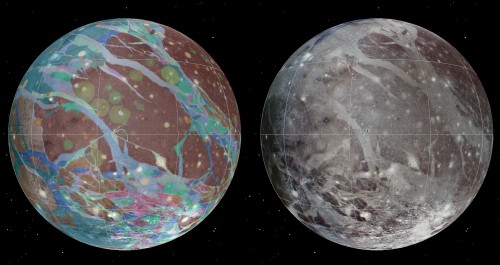Researchers used photographs of Jupiter's large moon taken by spacecraft exploring the Jupiter system to compile a detailed map of it

Over 400 years after its discovery by Galileo, the largest moon in the solar system got its own map.
A team of scientists led by Wes Patterson of the Applied Physics Laboratory at Johns Hopkins University in Maryland and Jeffrey Collins of Wheaton College in Massachusetts have created the first global geologic map of Ganymede, one of Jupiter's four Galilean moons. The map published by the "US Geological Survey", demonstrates the various geological formations on the surface of Ganymede and is the first map of a glacial moon of one of the outer planets.
The researchers used images taken by the Voyager and Galileo spacecraft. Ganymede is the fourth mapped moon after Earth's moon, and Jupiter's moons Io and Callisto.
"By mapping Ganymede's surface we can now answer scientific questions concerning the formation and evolution of this unique moon," Patterson said.
Since its discovery in 1610, Ganymede has been the focus of repeated observations, first of course by ground-based telescopes and in the 20th century by spacecraft that passed by or circled the Jupiter system. The studies revealed a complex glacial world whose surface is characterized by sharp contrasts between the two types of land: the dark and ancient areas covered in craters, and the light, slightly younger (but still ancient) areas full of grooves and ridges.
Ganymede, whose diameter is 5,262 km is larger than both Mercury and the dwarf planet Pluto and of course also our moon (which is 3,474 km in diameter). It is also the only moon in the solar system that formed and evolved during most of the solar system's history. These formations record events in Ganymede's internal evolution, its dynamic interactions with the other Galilean moons, and the development of small bodies that impacted Ganymede's surface.
The new map will be an important tool for researchers who wish to compare geological features on other icy moons, because almost all types of features found on other icy moons are represented somewhere on Ganymede, and with an area that is about half the size of the land area on Earth, Ganymede offers a wide variety of viewing sites. "Ganymede is also full of ancient formations alongside formations that were formed not long ago, which adds historical diversity to the geographical one." Collins noted.
The map can be downloaded at this link

2 תגובות
Io Ganymede Europa and Callisto - the four major Jupiter moons discovered by Galileo
"Galileo's moons" refers to the moons that Galileo discovered or is it a mistake and refers to Jupiter's moons?